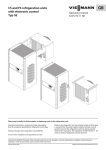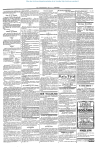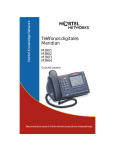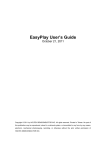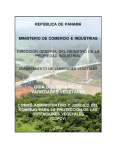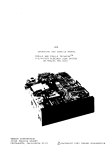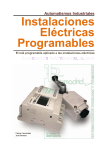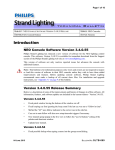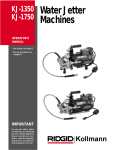Download S-Cam CS1300.22 User's Manual
Transcript
Operator’s Manual GPM HP CS1000.22 1000 2.2 1.5 CS1300.22 1300 2.2 2.0 Model PSI Thank you Thank you for selecting our products. Our personnel have proudly made every effort to ensure that your new pressure washer is of the quality you expect. But things do occasionally go wrong. This is why every pressure washer is covered by a limited warranty. Among other things, this warranty provides for the replacement of parts found to be defective during the operation of your new pressure washer. Please note that the owner/operator has certain obligations under the terms of the warranty. Be sure to read this manual for directions on proper installation, start-up, use, and storage of your pressure washer. Your new pressure washer was tested after production for proper pressure and flow. Please note that this process will sometimes leave a water residue in the pump. The dealer you have purchased your new machine from should review with you the proper installation, start-up, use, and storage. Most ‘big’ problems occur when shortcuts are taken in one of these processes. If a problem occurs that you need some assistance with, please feel free to contact us at the listing below: Please make note of Model Identification Model Warranty Service Center Code 520 Brooks Road Serial # Iowa Falls, IA 50126 Always have this information when calling 1.800.648.6007 Warranty Service Center. Be familiar with the model plate located on your machine. Have the model and code number with you when you call for service. Statement of warranty The manufacturer of this pressure washer agrees to repair or replace designated parts that prove defective within one year from date of original purchase. Specific limitations and exclusions apply. To make claim under the terms of the warranty, all parts said to be defective must be returned to the Warranty Service Center listed above for warranty inspection. The judgments and decisions of the factory personnel concerning the validity of warranty claims are final. Items not covered by the warranty given by us include motors, engines, and pumps. These components are covered by warranties given by their respective manufacturers. These warranties pass through to the end user. As a factory authorized and trained warranty service center, the factory will honor the terms of all component warranties and satisfy claims of the appropriate warranty provisions. Normal wear items are not covered by this warranty. Normal wear items include hoses, nozzles, filters, valves, and seals. This warranty does not cover the following: machines used for rental purposes, damage resulting from shipping, accident, abuse, misuse, or neglect. Also not covered is damage from repairs or alterations performed by nonfactory authorized personnel or failure to install and operate equipment according to the guidelines put forth in the instruction manual. The manufacturer will not be liable to any persons for consequential damage, for personal injury, or for commercial loss. WARNING The following warnings must be followed, Failure to follow these warnings could result in serious personal injury or death! Never allow children or untrained personnel to operate machinery. Electrical equipment can cause shock and sparks. Do not bypass or remove the grounding prong in any electrical plug. Keep electrical plugs, connections and cords out of water and moisture. Refer to instructions prior to equipment operation. Disconnect from power source before servicing. Inspect and repair damaged or exposed electrical components prior to use.Never splice electrical cords on pressure washers. Be sure the electrical service is adequately sized for the equipment. Exhaust gases contain harmful gases. Use only in well ventilated areas or vent the exhaust to the outside. Exhaust gases can cause death or serious injury. THIS EQUIPMENT MUST BE VENTED. High Temperature Water. Wear protective clothing and face shield. Do not direct water stream toward self or others. All hoses should be secured in the lines to be cleaned at least 5 feet. High pressure water can cause death or serious injury. High pressure fluid can create a high pressure stream or ruptured vessel. Wear safety face shield. Relieve pressure before servicing. Do not modify/repair/rework vessel or change safety relief or pressure setting. Do not direct stream toward self or others. Pressurized fluid streams and ruptured pressure vessels can cause death or serious injury. Kerosene, Fuel Oil or Gasoline will burn when ignited. Wear face shield and protective clothing. Do not expose fuel to flames, sparks or other sources of ignition. Use in well ventilated area or vent to outside area. Fire can cause death or serious injury. Initial setup and operation of your new jetter/pressure washer Inspection for freight damage When you receive your pressure washer, be sure you check for concealed freight damage. Any damage should be noted with the delivering carrier. If you have any questions related to freight, call the 800 number listed on the inside front cover of the manual. Inspection of oil levels Check all oil levels in the pump or engine, if applicable. Failure to check all levels will result in equipment damage. Most pumps are shipped with oil from the factory and the crankcase is sealed. You may have to remove a shipping plug and install a dipstick in the pump. Water supply Your water supply must provide water to the equipment that exceeds the Gallon Per Minute (GPM) rate of your machine. You can check your GPM by using a five-gallon bucket and a timer. If your machine is five GPM or less and the bucket fills in less than a minute you have adequate supply. Some systems are affected by washing machines, livestock watering systems, and flushing of toilets. Be sure the supply is still adequate when these operations are taking place. The water temperature cannot exceed 145 degrees Fahrenheit. Pressure should not exceed 60 PSI. Failure to secure adequate water supply will result in pump damage. Do not run pump dry! Water quality Your water supply should not contain particles larger than 80 microns. Although there are small filters installed on pressure washers that filter the water, they can only filter poor quality water for a short period of time before clogging. This will result in damage to the machine. Therefore, you should insure no sand or scale particles are present in the water supply. Supply hose Hook a garden hose from the hydrant to the machine. When doing this, be sure to check the inlet water filter or screen. This hose should be at least 5/8” diameter with a length at least 15 feet. This 15’ length helps isolate the water supply from pulsations from the pump. Many states require a vacuum break or backflow preventor be installed at the hydrant, before the garden hose, to insure the water source cannot be contaminated. Be sure to check local and state regulations upon installation. Purge air Turn on the water supply and open the trigger gun. This will purge all the air from the system. Look for water leaks and stop any leak found. Leaks can cause erratic pump behavior. Electrical Supply A circuit dedicated only to the pressure washer is recommended. This circuit should be installed by a licensed electrician and checked to supply adequate voltage Under Load . Sometimes the distance from the panel is to long, the wire size is to small or the voltage is initially to low, this will cause the GFCI or thermal to trip. If the GFCI trips or the thermal overload on the motor trips consult factory. Plug your cord into the receptacle. DO NOT USE AN EXTENSION CORD! Pump Prior to turning on the power switches check the oil level in the pump. In drain jetting applications, the hose must be inserted into the drain line at least five feet before starting water flow. Be sure machine is not powered on before hose is inserted into the drain. Federal and State Regulations Many areas are governed by state and federal regulations that protect the environment and water quality. In operating this equipment you are also to act responsibly. Be sure to check with the local, state and federal authorities on compliance issues. During operation The pressure was set at the factory during the testing procedure; no adjustments to the machine should be required for operation. During operation, do not leave the machine running for more than two minutes without the trigger gun being pulled. Although your machine has a by-pass valve on it and may have a thermal relief system, this pressure build-up can cause extensive pump damage. If machine will not be discharging water for more than two minutes, shut the machine off. Accessory operation Use extreme caution when attaching devices to the discharge of this equipment. Allow only trained individuals to operate this machinery. The attachments must be rated to operate within the pressure range of the equipment or injury could occur. Only use attachments designed, rated, and sized for the equipment by the manufacturer. Hose and reels The discharge hoses and fittings should be inspected before every use. Also inspect the connections made on the hose reels. Refer to accessories listing and exploded views included for specifications and replacement parts. Hose sizing For pressure wash applications, the ideal hose to deliver adequate water flow and pressure at distances up to 300 feet is a 3/8” ID hose with a minimum burst pressure rating no less than four times the operating pressure of the equipment. For drain jetting and sewer cleaning, a hose should be selected for the adequate pressure range and length needed. The diameter of the hose should be chosen from the chart below for the application requirements. Hose size 3/8” or 5/16” 1/4” 1/8” Hose size considerations Pipe size 4” to 8” lines 2” to 4” lines 1” to 2” lines Typical application Floor drains, septic lines, and long runs Kitchen, laundry drains, and clean-outs Tight bends, bathroom and trap lines -Remember, when selecting a hose, the smaller diameter and longer the hose, the greater the pressure and flow loss will be. -Do not couple hoses together for drain jetting. The long couplings will get caught in bends in the drain lines. -When drain jetting, always attach a shut-off valve, trigger gun, or foot valve directly to the hose to be inserted in the drain. This ensures safe shut-off of the water flow at the user’s discretion. In drain jetting applications, the hose must be inserted into the drain line at least five feet before starting water flow. Be sure machine is not powered on before hose is inserted into the drain. Be sure machine is shut down before removing the hose from the drain. Always be sure hose is marked at the point five feet from the nozzle to identify nozzle position. Drain and trap hoses Drain and trap hoses listed in the accessory sheet are fitted with a twist-fast coupler. Your drain jetting equipment is shipped with an assortment of twist-fast couplers to make the necessary connections for the drain hose to be installed either on the existing hose, by removing the drain nozzle, or by installing it directly to the foot valve included on some models. Nozzles The nozzle, or tip, of the machine is used to restrict the discharge water flow to achieve the rated operating pressure of the equipment. Only use a properly sized nozzle for your equipment. The nozzle should be inspected before every use for obstructions and nozzle wear. New nozzles can be selected from the accessory sheet enclosed in the Operator’s Manual folder pocket. Shut-down procedure Shut-down Storage 1. Turn off the power switch on the pressure washer. 2. Relieve pressure on line by pulling trigger gun. 3. Shut off water supply and disconnect garden hose. 4. Be sure to check for water leaks or oil leaks that should be repaired before the next operation. 5. If you are going to store the machine for extended periods of time in cold climates be sure to anti-freeze the equipment. A 50% anti-freeze solution may be drawn in through the inlet of the pump using a short remnant of garden hose. This fluid should be run through the pump. When the fluid is discharged from the pump discharge your machine is winterized. Do not allow machine to freeze. Pump The pump oil should be changed after the first 50 hours of operation. Then change every year after that for average use. Oil should be changed more frequently for extensive use or use in dusty areas or areas with high moisture. Filters Water filters, hoses, and fittings should be checked prior to every operation for cleanliness, leaks, and needed repair or replacement. Troubleshooting Despite the complexity of your jetter, a number of common complaints stem from relatively simple problems. With guidance, the user can identify and remedy many common problems. Always disconnect the power supply before attempting to service any equipment. Common problems and solutions Malfunction Cause Remedy Unit runs but no water discharges -Water supply not turned on -Plugged nozzle on discharge -Shut off valve is malfunctioning -Turn on water supply -Remove, clean, or replace nozzle -Remove, repair, or replace valve Low nozzle pressure -Plugged spray nozzle -Inlet screen is plugged -Insufficient water supply -Unloader valve stuck open -Plugged inlet or discharge hose -Use of additional lengths of hose -Remove and clean or replace nozzle -Remove and clean or replace filter -Secure adequate water supply -Disassemble and clean, repair, or replace -Flush or replace hoses -Reduce discharge hose length Surging pressure or drop in pressure -Partially plugged spray nozzle -Worn nozzle -Soap (low pressure tip installed) -Restricted or leaking inlet hose, filter -Cavitation (inadequate water supply) -Worn pump packings -Fouled inlet or discharge valves -Broken valve spring -Worn or restricted unloader valve -Remove and clean or replace nozzle -Remove and replace nozzle -Remove and install one of the nozzles -Check inlet hose, filter; clean or replace -Secure adequate water supply -Inspect and replace worn packings -Inspect and clean or replace valves -Inspect and replace valve spring -Inspect, repair, or replace unloader Pressure at pump but low discharge pressure -Restricted discharger -Check for discharge obstructions in injector, gun, hose, valve, wand, and unloader. Chemical injector not working properly -Soap nozzle (low pressure tip) not installed -Injector valve not turned on -Discharge hose too long -Clogged injector pick up hose -Clogged injector -Install nozzle with large hole -Turn on injector by turning fitting on injector -Reduce hose length or reposition injector to within 40’ of trigger gun -Remove, clean, and replace -Disassemble, clean, and reassemble Water leaks from pump manifold -Worn plungers or packings -Inspect and replace Unloader does not bypass -All valves fouled -Unloader valve seat fouled -Inspect, clean or replace -Inspect, clean or replace Unloader assly. Unloader cycles when gun is shut off -Leak in trigger or discharge line -Inspect, repair or replace leaking fittings Water in crankcase -High humidity or direct water spray -Worn seals -Reduce oil change intervals -Replace seals Pump TT9061EFUI Coupler fittings 527810 F x F 527715 Mx F Hose 3/16 x 100’ 519033H Reel Asly 526496.6 Hose, Leader 509096 525116 Ball Valve Thermal Valve 509312 Valve, Pulse GEN100315 Wheel 10x 4 524566 Bracket, Reel 526569.1 Tip, Laser LAS18-CS1300.2 LAS18-CS1000.2 Swivel 526493 Handle 510411T.2D Motor 521350 (1.5hp) 521308.1 (2hp) Lynch pin 526521 524100 Rubber foot Switch 526305 510411T.B Base, Cart EDP # DESCRIPTION LIST HIGH PRESSURE CHEMICAL INJECTOR The stainless steel construction makes this nozzle suitable for various soaps, sanitizers, fungicides and chemical cleaning solutions. Nozzle barrel propels a concentrated spray pattern up to 25-35 feet. Stainless steel construction provides high strength and chemical resistance. Adjustment knob at nozzle body allows for convenient chemical metering. 30’ of chemical hose and a check valve which prevents reversal of solution back to the chemical container are standard features. Weighted strainer filters unwanted debris from entering the chemical stream. CAT 7314 #4 HIGH PRESSURE INJECTOR CAT 7315 CAT 7316 #5 HIGH PRESSURE INJECTOR #6 HIGH PRESSURE INJECTOR Use with 1000 [email protected] GPM Use with 3000 [email protected] GPM Use with 1500 [email protected] GPM Use with 2000 [email protected] GPM $124.60 $124.60 $124.60 JETTER ACCESSORIES 519039 519040 519041 TRAP HOSES 1/8” x 25’ TRAP HOSE 3000# MAX 3/16” x 25’ TRAP HOSE 4000# MAX 3/16” x 50’ TRAP HOSE 4000# MAX $55.00 $75.00 $135.00 519033 519033.1 509083.5H 509083.4 REPLACEMENT HOSES FOR JETTERS 3/16” x 100’ HOSE 3000# MAX 3/16” x 200’ HOSE 3000# MAX 5/16” x 100’ HOSE 4000# MAX 5/16” x 200’ HOSE 4000# MAX $240.00 $475.00 $245.00 $570.00 509089.200 509089.300 509089.400 509089.500 REPLACEMENT HOSES FOR TRAILER JETTERS 1/2” x 200’ HOSE 3000# MAX 1/2” x 300’ HOSE 3000# MAX 1/2” x 400’ HOSE 3000# MAX 1/2” X 500’ HOSE 3000# MAX $1675.00 $2475.00 $3325.00 $4150.00 DRAIN NOZZLES FOR JETTERS RAM18-MODEL 1/8” F RAM NOZZLE RAM14-MODEL 1/4” F RAM NOZZLE LAS18-MODEL 1/8” F LASER NOZZLE LAS14-MODEL 1/4” F LASER NOZZLE COR18-MODEL 1/8” F CORNER NOZZLE COR14-MODEL 1/4” F CORNER NOZZLE REV18-MODEL 1/8” F REVOLVING NOZZLE REV14-MODEL 1/4” F REVOLVING NOZZLE $40.00 $45.00 $40.00 $45.00 $40.00 $45.00 $136.75 $205.13 DRAIN NOZZLES FOR TRAILER JETTERS RAM38-MODEL 3/8” F RAM NOZZLE LAS38-MODEL 3/8” F LASER NOZZLE COR38-MODEL 3/8” F CORNER NOZZLE REV38-MODEL 3/8” F REVOLVING NOZZLE $55.00 $55.00 $55.00 $250.00 200DS3 200DS4 PORTABLE REEL 3/8” x 200’ 3000#/CART/SHUTOFF PORTABLE REEL 3/8” x 200’ 4000#/CART/SHUTOFF $1400.00 $1400.00 509859H 509859 HONDA L.P. CONVERSION KIT VANGUARD L.P. CONVERSION KIT $492.91 $492.91 509374J 542040 542041 542042 PRESSURE WASH ATTACHMENTS PRESSURE WASH GUN #4 MULTI-REG TIP #5 MULTI-REG TIP #6 MULTI-REG TIP $72.39 $34.94 $34.94 $34.94 Ram Corner Laser Revolving









